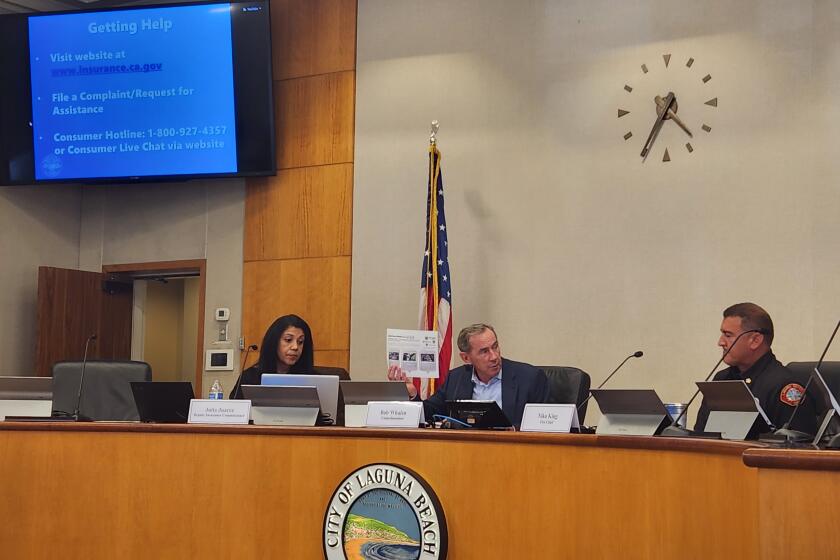Laguna Beach restores wildfire mitigation committee amid community concerns

- Share via
In light of the January wildfires that devastated the Los Angeles area, Laguna Beach residents have been sounding the alarm with regard to a need to do more to protect the coastal community.
City officials have heard those growing concerns since the Palisades and Eaton fires, among others, broke out.
On Tuesday, the City Council took action to reestablish the wildfire mitigation and fire safety ad hoc committee, appointing council members Sue Kempf and Bob Whalen as its representatives.
“We need to recognize that we’re all kind of in this together,” Kempf said. “City government can’t do everything here to keep us safe. We’re going to do every single thing we can, but people are going to have to create defensible space around their homes, they’re going to have to harden their homes, and we’re probably going to take a very aggressive approach on this because this is a huge problem.”
Kempf and Whalen served on the subcommittee that helped bring about the wildfire mitigation and fire safety plan in 2019. The plan allocated $23 million for various short-term and long-term initiatives. A total of 46 projects spanning the areas of evacuation, fuel modification, infrastructure and notification measures are included in the report.
“We spent over $20 million of your money to make this community safer than it was in 2018, and it is definitely safer, but is it safe enough? No, it’s not safe enough,” Whalen said. “We know we have more to do. We know we have to keep going, and we will keep going.”
Laguna Beach has implemented a number of programs to protect itself from wildfire. Goat grazing has been part of fire mitigation efforts for nearly three decades.
Among the recommendations implemented so far: The city has installed an emergency outdoor warning system, adopted guidelines for residential defensible space and placed several fire detection cameras in the open space.
“I think [in using the artificial intelligence] wildfire cameras we should cover our whole open space with them because you have to get to a fire within five minutes to really have a chance of putting it out,” Mayor Alex Rounaghi said. “I know when we had these crazy winds, I was so nervous that there was going to be a fire that would start. I know we had people watching and stuff, but I think technology is a key solution.”
A helicopter water refilling tank has been installed along the fire road, and a second tank is located at the water district property of El Morro Elementary School in North Laguna.
An interactive map detailing evacuation routes for specific neighborhoods is available through the city’s website. A search for the word “evacuation” pulled up a list of 20 neighborhoods with information about their evacuation routes, as well as helpful tips on types of evacuation orders and readiness for such situations.
About 30% of the city has yet to have its utility lines put underground, according to a city staff report, although several neighborhoods have recently agreed to become part of underground utility districts.
“There isn’t going to be enough money to do everything we need to do,” Whalen said. “I, and our council at the time, pushed in 2018 to get a sales tax measure, went to the ballot, primarily for fire safety measures, [but it] did not pass. I think we’re going to have to have that conversation again as a community. Are we willing to spend a little bit more of our money to promote safety, preserve our homes, preserve our ability to get fire insurance?
“It’s really not too much to say this is an emergency. We are in constant threat, and I think we can do more, and we need to do more.”
Laguna Beach residents turned out en masse for a town hall meeting on the issues of insurance and wildfire on Tuesday.
In August, residents packed City Hall for a meeting that focused on fire insurance as rates for such coverage were skyrocketing and some companies were canceling policies for homes in vulnerable areas. It’s unknown how many homeowners found replacement policies, but the timing of the meeting may have been fortuitous. Less than five months later, when the Palisades and Eaton fires destroyed about 16,000 homes in one of the nation’s most expensive natural disasters to date, California’s affordable home insurance crisis caught those who had not renewed or replaced their policies unprepared to rebuild.
Beyond restoring the ad hoc committee, the Laguna Beach City Council has also directed the committee members to work with the League of California Cities and state representatives as advocates for legislation that would exempt fuel modification, undergrounding and other wildfire measures from requirements of the Coastal Act and the California Environmental Quality Act.
The subcommittee members will engage in community outreach and continue to exchange ideas with residents and other stakeholders, including neighboring cities and O.C. Parks, City Manager Dave Kiff said. Priority will be placed on what he called “fast efforts.”
Those efforts could include limits on construction and parking during red flag days in an attempt to manage traffic and keep roads open. Kiff added that the city could have evacuation drill days and conduct a study into brush density with regard to fuel modification.
“There’s a way to do fuel management in an environmentally sustainable way that supports our coastal sage scrub habitat, and we need to be looking at that,” said Councilwoman Hallie Jones, who added she will be sending a list of recommendations to Kiff to pass on to the committee.
The few public speakers on the agenda item were all in support of the city ramping up its efforts with respect to wildfire mitigation and fire safety. Matt Lawson, a longtime resident, called on the city to better integrate into the discussion its emergency disaster preparedness committee, a body he previously served in the role of chairman.
“We have done a great deal here, but nothing that you’re going to do tonight, nothing that the city has done in the last 100 years is going to much matter if we don’t get the fire prevention piece right,” Lawson added.
Resident John Thomas commented that his family lost a house in the Palisades fire. He said they lived in the house, which they had kept as a rental, until moving to Laguna Beach.
“We’re all vulnerable here, regardless of whether we think we’re safe,” Thomas said. “We all need to do everything that you’re talking about in terms of hardening our homes. … The similarities between the Palisades and Laguna are unsettling. They’re striking. Three ways in, three ways out, open space, ocean. … They needed an evacuation plan. You did one, which is great, but theirs didn’t work.”
All the latest on Orange County from Orange County.
Get our free TimesOC newsletter.
You may occasionally receive promotional content from the Daily Pilot.






